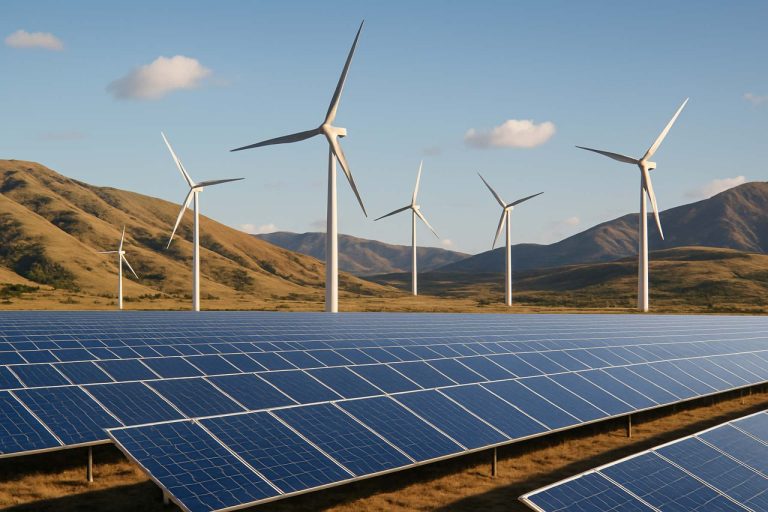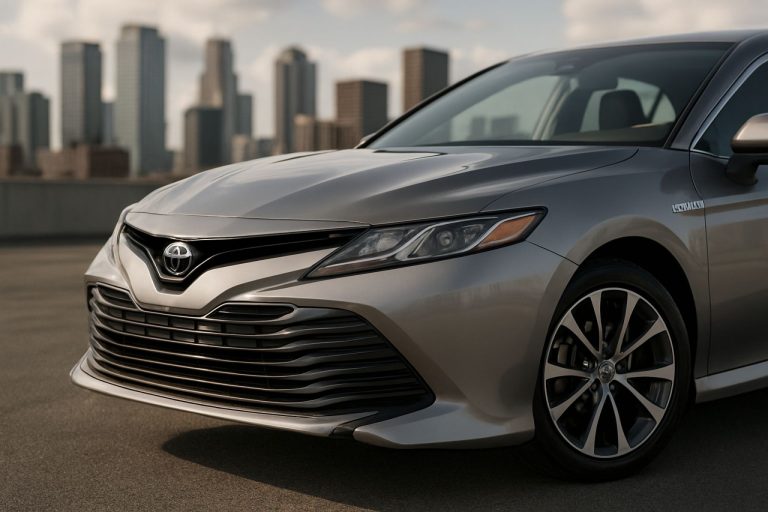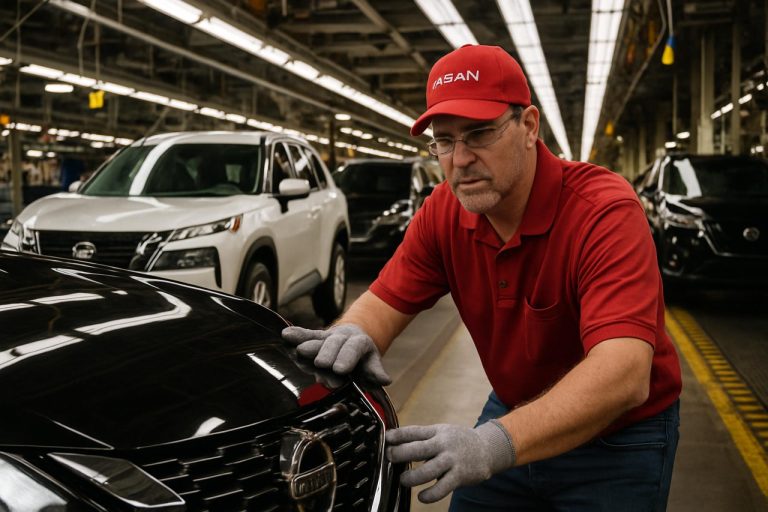
- Nissan is enacting major cost-cutting measures, including up to 20,000 job cuts and buyouts for U.S. workers, to address falling sales and intense global competition.
- The Canton, Mississippi plant will shift to electric vehicle (EV) production, but manufacturing delays mean new EV models may not debut until 2028.
- The company is pausing wage increases worldwide and seeking nearly $7 billion in new funding to pay down debt and support its recovery plan.
- Nissan’s recovery hinges on ten new or refreshed models for the U.S. market by 2027, including a revamped LEAF and an “adventure-focused” SUV.
- Despite investments in hybrids and e-Power technology, analysts warn Nissan’s cautious approach may risk falling behind faster-moving EV competitors.
Steel city silence blankets the sprawling expanse of Nissan’s Canton, Mississippi plant—once a humming beacon of the automaker’s American dreams, now a crucible for a struggle that will define the company’s future. Nissan, battered by falling sales and fierce global competition, has initiated a dramatic phase of cost-cutting, offering buyouts to U.S. workers in a bid to refuel a comeback and restore its former glory.
Tough realities stare Nissan in the face. The carmaker’s bold multi-year recovery plan pivots on aggressive action: the company intends to cut approximately 20,000 jobs, trimming 15% of its worldwide workforce by 2027. Factories shutter and production lines dwindle as the Japanese giant seeks to slash costs by 250 billion yen—just over $1.6 billion—in its quest to revive sliding profits. Delays in EV launches and suspended raises add to the internal upheaval rippling from Tokyo to Mississippi.
For Nissan, the U.S. market holds the key to global relevance. The urgent buyouts at Canton underscore the extent of the challenge. While the company invested $500 million to retool the plant for electric vehicle (EV) production, manufacturing delays mean the electric shift won’t hit the assembly lines until at least 2028. Workers, once proud to roll out Altimas and Titans, now face uncertainty as the automaker reimagines its American fleet—heralding the imminent arrival of a sleeker LEAF, longer-legged and equipped for the era of universal North American charging standards.
The backdrop, though, is unforgiving. Rivals such as BYD and upstart Americans like Rivian and Lucid quicken the pulse of innovation. Nissan’s decision to ditch plans for a game-changing lithium-iron phosphate battery plant in Japan illustrates its retrenchment, even as these cheaper batteries turbocharge competitors’ success worldwide. Meanwhile, Nissan eyes the hybrid path pioneered by Toyota and Honda, banking on upgraded e-Power technology and hybrid models to bridge the gap—though analysts say this pivot may prove too slow and conservative for a market racing toward full electrification.
Pressure mounts not only from industry trends but also from the balance sheet. Reports suggest Nissan is seeking to raise a mammoth 1 trillion yen—almost $7 billion—backstopped by the U.K. government to pay down looming debts, a move that hints at the scale of obstacles ahead. Global wage increases are paused, and American shores are now the proving ground for a new era of “right-sizing.”
Yet within corporate turbulence, opportunity stirs. Nissan’s U.S. comeback plan promises ten new or refreshed models by 2027, from the reinvigorated LEAF to a much-anticipated “adventure-focused” SUV. The gambit is simple: reclaim relevance, loyalty, and profitability in the world’s most important car market, or risk obsolescence in a rapidly transforming industry.
The takeaway: Nissan stands at a pivotal crossroads—its survival in the U.S. rides on bold, painful bets and the willingness to reshape its legacy vehicle by vehicle. For employees and drivers alike, the next few years promise uncertainty, but also the prospect of transformation. The global race for the electric future has no patience for hesitation.
For more on how the auto industry is transforming, visit Nissan USA or follow breaking business news at The New York Times.
Nissan’s Make-Or-Break Moment: Can Bold Restructuring and EV Bet Save the Iconic Automaker?
# Nissan’s High-Stakes U.S. Revival: Unexplored Realities, Market Forecasts & Actionable Insights
Nissan’s recent dramatic moves at its Canton, Mississippi plant are more than a tale of layoffs and buyouts—they’re a microcosm of the seismic shifts upending the global car industry. While headlines focus on job cuts and cost containment, several factors and industry trends behind the scenes are shaping Nissan’s fate in ways that deserve deeper analysis.
—
Additional Facts & Insights Not Fully Explored
1. Global EV Landscape: Nissan’s Position & the Cost of Delay
Pioneer at a Crossroads: Nissan was a forerunner in electrification with the original LEAF, but now trails rivals in next-gen battery tech and fast-charging infrastructure ([Nissan USA](https://www.nissanusa.com)). China’s BYD and Tesla have already pushed EV tech ahead: BYD’s sales in Q1 2024 overtook Tesla’s in some markets, leveraging cheaper LFP batteries and rapid innovation ([source: Bloomberg]).
Real-World Use Case: Nissan dealers report declining demand for aging ICE models, underscoring the urgent need for competitive, long-range EVs.
2. Missed Opportunity: LFP Battery Plant Abandonment
Industry Trend: The lithium-iron phosphate (LFP) battery is lauded for safety, affordability, and longevity. Losing this tech edge sets Nissan back, as Ford, Tesla, and BYD ramp LFP deployment for mass-market EVs.
Controversy: Critics say retreating from LFP undermines Nissan’s ability to offer affordable EVs—critical as federal U.S. tax credits increasingly favor domestically manufactured, lower-cost batteries (source: Reuters).
3. Financial Health & Global Debt: Deeper Dive
Debt Picture: S&P Global cites Nissan’s debt standing at over $16 billion as of early 2024. The move to secure up to $7 billion with U.K. government backing is rare for a Japanese automaker and hints at industry-wide cash flow anxieties.
Market Forecast: Moody’s projects slow revenue recovery, warning that Nissan’s global market share could slip below 4% by 2025 if new products and EVs fail to resonate.
4. Retooling: More Than a $500 Million Investment
Specs & Timeline: Retooling the Canton plant for next-gen EVs is an unprecedented logistical feat, requiring advanced robotics, new supplier partnerships, and workforce retraining programs.
– Production for new LEAF and SUV models is delayed until at least 2028, risking missed windows as competitors flood the market sooner.
5. U.S. Product Strategy: 10 New Models & Adventure SUVs
Preview: Beyond the all-new LEAF, Nissan teases three-row SUVs to rival Jeep and Ford, with AWD, larger battery packs, and North American Charging Standard (NACS—same as Tesla) compatibility. This alignment is crucial as NACS emerges as the de facto EV charging ecosystem in North America.
6. Labor Implications: Buyout Details & Workforce Innovation
– Buyouts target senior, higher-wage workers: Often those hardest to replace, risking knowledge drain.
– Life Hack for Workers: Upskilling in EV maintenance, robotics, and software integration can future-proof careers—even outside Nissan.
7. Reviews & Comparisons: Nissan vs. The Field
Pros:
– Strong manufacturing base in U.S.; sizable dealer footprint.
– Experience launching EVs at scale (global LEAF sales > 600,000 units).
– Hybrid “e-Power” tech excels in fuel economy and city driving.
Cons:
– Launch delays put Nissan years behind Tesla, Hyundai, and Ford.
– Product lineup perceived as aging.
– Lacks premium EV brand cachet compared to Lucid or Rivian.
8. Security & Sustainability
Sustainability: Nissan’s EVs help reduce emissions, but lack of local battery production means higher supply-chain emissions versus “full stack” U.S.-made competitors ([source: EPA]).
Cybersecurity: As vehicles become software-defined, Nissan will need to harden its connected car tech to avoid remote hacking vulnerabilities—a concern industry watchdogs raise for all legacy automakers.
—
Pressing Questions: Nissan’s Future Answered
Q: Is Nissan leaving the U.S. market?
– No, the company is doubling down: investing in U.S. manufacturing and launching 10 new/refreshed models by 2027.
Q: Will current Nissan vehicles be supported?
– Yes. Existing cars will remain supported, but watch for faster software and parts upgrades in coming LEAF and Rogue EVs.
Q: How do Nissan’s new EVs compare?
– Upcoming models promise longer range (above 300 miles), faster charging (NACS), and competitive pricing, but rollout will be slower than rivals.
—
Quick How-To Steps: Transitioning from ICE to Nissan EVs
1. Research Tax Credits: Check eligibility for up to $7,500 federal incentive on U.S.-built Nissan EVs.
2. Compare Range & Price: Stack Nissan’s offerings against Hyundai, Ford, and Tesla before ordering.
3. Install NACS-Compatible Home Charger: Prepares your home for new Nissan models.
4. Bookmark Recall Notices: EV tech evolves fast—register VIN for Nissan safety updates.
—
Actionable Takeaways & Recommendations
– For drivers: If considering a Nissan, lease instead of buying for now—gives flexibility until updated EVs arrive.
– For workers: Upskill in high-demand EV technologies; consider community college programs on battery repair or mechatronics.
– For investors: Watch Nissan’s U.S. sales quarterly trends; a successful LEAF relaunch is key. Market share recovery—or further decline—will likely show by early 2026.
– For the environmentally conscious: Prioritize models with recycled-content interiors, or delay purchase until Nissan onshores battery production for lower lifecycle emissions.
—
Industry Prediction & Final Word
Unless Nissan accelerates its EV launches and innovates aggressively—beyond hybrids—the competitive gap may widen irreversibly. If you’re betting on which brands win the U.S. EV race by 2030, prioritize those already shipping affordable, tech-forward models in 2024–2025.
For further updates on Nissan and the fast-shifting automotive scene, visit Nissan USA or follow industry developments via The New York Times.



